While there is nothing wrong with doing bodyweight-only workouts at home, you’ll get even better benefits if you add just a single dumbbell to your workout arsenal. The addition of one dumbbell will not only add variety to your workouts; it will also make training more productive.
Not sure how to incorporate a single dumbbell into your current training regimen? Here are seven of the best one dumbbell (and bodyweight) workouts you can do at home.
1. Left to right full-body workout
For this workout, do all the reps on your left side before resting for a moment and then repeating the exercises on your right. This will help identify and fix and left to right strength imbalances.
Do four laps and 12-20 reps of the following exercises per side, depending on your fitness and the weight of your dumbbell. Remember to do all the reps for your left side before repeating the circuit on the right.
- Single-arm swings
- Single-arm thrusters
- Single-arm bent-over rows
- Single-arm floor press
- Single-arm half get-ups
Exercise descriptions
1 – Single-arm swings
Swings work your posterior chain, which is the collective term for the muscles on the back of your body, including your hamstrings, gluteus maximus, and erector spinae. Because you are using just one dumbbell, this exercise also works your core and especially your obliques, which have to work extra hard to stabilize your spine and prevent rotation.
Level Up Your Fitness: Join our 💪 strong community in Fitness Volt Newsletter. Get daily inspiration, expert-backed workouts, nutrition tips, the latest in strength sports, and the support you need to reach your goals. Subscribe for free!
How to do it:
- Hold your dumbbell in your left hand and stand with your feet shoulder-width apart. Bend your legs slightly, push your butt backward, and lower the weight between your knees.
- Keeping your arm straight, drive your hips forward, and swing the weight up to shoulder-height. Swing it back down and repeat.
- Keep your hips and shoulders square, and do not round your lower back.
2 – Single-arm thrusters
Thrusters work your deltoids, triceps, core, and legs all at the same time. Using just one dumbbell increases oblique activation, which are the muscles that make up your waist. They’re also useful for increasing your heart and breathing rate.
How to do it:
- With your dumbbell in your left hand, curl the weight up and hold it at shoulder-height. Step out and into a shoulder-width stance.
- Bend both legs and squat down until your thighs are roughly parallel to the floor.
- Stand up explosively and use this momentum to push the dumbbell up and overhead.
- Lower it back to your shoulder and repeat.
- Keep your core braced and your torso upright throughout.
3 – Single-arm bent-over rows
This classic lat and biceps exercise is usually done with one knee and hand resting on a bench. For this workout, do your single-arm rows freestanding and unsupported to make them more demanding.
How to do it:
- With your dumbbell in your left hand, stand with your feet about hip-width apart. Bend your knees slightly, lean forward from your hips, and incline your body to about 75-90 degrees. Let your arm hang down from your shoulder.
- Without twisting your hips or shoulders, or rounding your lower back, row the dumbbell up and into your ribs. Extend your arm and repeat.
4 – Single-arm floor press
The floor press is a chest and triceps exercise that’s an excellent alternative to push-ups and bench press. This move is easy on your shoulders, which means it’s popular with banged-up weightlifters who want to bench press but find that it hurts their joints.
How to do it:
- Lie on the floor with your legs bent and feet flat. Hold a dumbbell in your left hand and press it up to arms’ length over your shoulder.
- Bend your arm and lower the weight down until your elbow lightly touches the floor. Keep your core braced to avoid rolling to one side.
- Press the weight back up and repeat.
5 – Single-arm half get-ups
Your final exercise is specifically for your core. It’s a simplified version of the Turkish Get-Up, which is a popular kettlebell exercise. Full get-ups can be hard to master, but this version is much easier.
How to do it:
- Holding your dumbbell in your left hand, lie on your back with your legs straight. Push the weight up toward the ceiling so your arm is vertical. Look up at the weight and keep your eyes fixed on it through the whole exercise.
- Bend your left leg and place your foot flat on the floor. Extend your opposite arm out to the side at 90-degrees to your body.
- Brace your abs and drive your foot into the floor. Sit up partway and push the weight up toward the ceiling. Simultaneously roll across onto the opposite forearm. Make sure you keep your weight-bearing arm vertical.
- Lie back down on the floor and repeat.
2. Burpee-snatch insanity
This workout is as brutal as it is simple. All you need is one dumbbell and a timer. Just crank out as many reps of burpee-snatches as you can in ten minutes. Swap arms whenever you want, but try and do roughly the same number of reps on each arm.
- Burpee-snatches
Exercise descriptions:
1 – Burpee-snatches
This exercise involves a whole lot of different moves rolled into one. It will test and develop your cardiovascular fitness, endurance, explosiveness, and coordination.
How to do it:
- Place a dumbbell on the floor between your feet, which should be about shoulder-width apart. Bend down, place your hands on the floor, and jump your feet back and out into the push-up position. Do one push-up.
- Next, jump your feet up to your hands. Without standing up, grab the dumbbell with one hand.
- Stand up quickly and pull the dumbbell up the front of your body. Bend your knees slightly and catch the weight at arms’ length over your head.
- Lower the weight to your shoulder, down to your waist, and then squat down and place it on the floor.
- Release the dumbbell, place your hands flat on the floor, and do another rep.
3. Let’s do legs!
For most exercisers, leg training means squats and deadlifts, usually performed with barbells. This workout is no less challenging or effective, but all you need is a single dumbbell.
Do 2-4 sets of 8-12 reps of the following exercises.
- Single-arm snatch to lunge
- Goblet squats
- Single-leg Romanian deadlift
- Bulgarian split squat
- Single-leg calf raise
Exercise descriptions:
1 – Single-arm snatch to lunge
This exercise combines two great moves in one. It works all of your leg muscles, and also provides your core and shoulders with some additional training.
- Stand with a dumbbell in your left hand, feet roughly shoulder-width apart. Hold the weight in front of your hips.
- Bend your knees, push your hips back, and lower the weight down between your knees.
- Stand up explosively, pull the weight up the front of your body, and, as you dip your knees, catch it at arms’ length overhead.
- Keeping your arm vertical, take a large step forward with your right leg, bend your legs, and descend into a lunge.
- Push off your front leg to stand back up, lower the weight back down, and then repeat. Do all your reps on one side before switching.
2 – Goblet squats
Goblet squats are a very useful alternative to barbell squats. Typically done with a kettlebell, you can also do this exercise with a dumbbell. Goblet squats work all your lower body muscles, especially your quads.
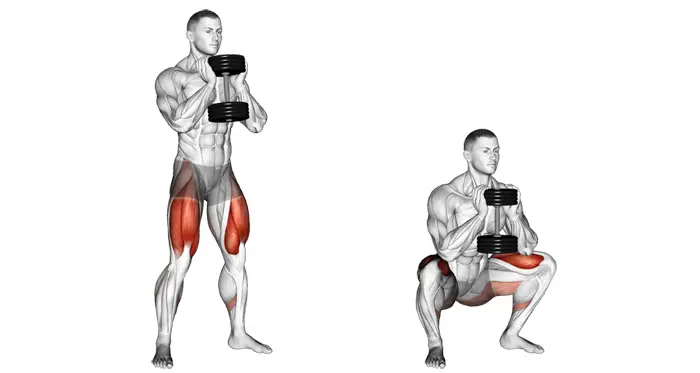
How to do it:
- Hold your dumbbell vertically in front of your chest with the innermost weight plate cupped in your upturned hands.
- Step out and into a shoulder-width stance, and toes turned slightly outward.
- Bend your knees and squat down until your thighs are roughly parallel to the floor. Do not round your lower back.
- Stand back up and repeat.
3 – Single leg Romanian deadlift
Single-leg RDLs work your hamstrings and glutes and are good for your balance too. If you find this exercise tricky, do it next to a wall and use your free hand for stability.
How to do it:
- Stand on your right foot with a dumbbell in your left hand. Bend your knee slightly for balance.
- Lean forward from your hips, lowering the weight down toward the floor and extending your other leg out behind you for balance.
- Stand back up and repeat. Do the same number of reps on both legs.
4 – Bulgarian split squat
While this exercise doesn’t have anything much to do with Bulgaria or Bulgarians, it’s a very effective way to work your quads, hamstrings, and glutes and work on your balance too.
How to do it:
- Hold your dumbbell vertically in front of your chest with the uppermost weight plate cupped in your upturned hands.
- Stand with your back to a knee-high bench, chair, or step. Bend one leg and place your foot on the platform behind you. Hop forward and into a split stance.
- Keeping your torso upright, bend your legs, and lower your rearmost knee down to within an inch of the floor. Stand back up and repeat.
- Do all your reps on one side, rest a moment, and then repeat on the opposite leg.
5 – Single-leg calf raise
Only having one dumbbell to train with does not mean you can’t work your calves. In fact, in some ways, this at-home, single dumbbell calf raise exercise is better than using a calf raise machine at the gym. Why? Because it involves more balance, and you’ll quickly spot any left-to-right strength imbalances. It might be low-tech, but it’s definitely high-effect!
How to do it:
- Place the ball of one foot on the edge of a sturdy step and stand on one leg. Hold a dumbbell in one hand and use your other arm for balance. Keep your supporting knee straight throughout.
- Lower your heel down toward the floor as far as your flexibility allows. Rise up onto your tiptoes and repeat.
- Do all the reps on one side before switching over.
4. Odds and evens EMOM swings and push-ups
EMOM stands for Every Minute On the Minute. It’s an effective way to control both workout timings and duration. For this workout, you are going to perform a set of two-handed dumbbell swings at the top of every odd minute, and a set of push-ups at the top of every even minute. Do ten sets of each to total 20 minutes.
- Two-handed dumbbell swings x 20
- Push-ups x 20
Exercise descriptions:
1 – Two-handed dumbbell swings
While swings are customarily thought of as a kettlebell exercise, they can also be done with nothing more than a single dumbbell. Two-handed dumbbell swings work your hamstrings, glutes, lower back, and upper back, and will drive your heart rate sky-high.
How to do it:
- Stand with your feet shoulder-width apart, knees slightly bent. Hold your dumbbell with both hands, interlacing your fingers if necessary.
- Hinge forward from your hips and lower the weight down between your knees. Drive your hips forward and, keeping your arms straight, swing it up to shoulder-height.
- Lower the weight and repeat. Do not round your lower back as this may lead to injury.
2 – Push-ups
The push-up is probably the most widely performed exercise in the world. They work your chest, triceps, and deltoids, and your core and even your legs get an indirect workout too. Done correctly, the humble push-up can be every bit as beneficial as the bench press, and it’s a much better choice for home and conditioning workouts.
How to do it:
- Squat down and place your hands on the floor, shoulder-width apart. Walk your feet back until your legs and hips are straight, and your shoulders are directly over your hands. Pull your shoulders down and back and brace your abs.
- Bend your arms and lower your chest to within an inch of the floor. Do not allow your hips to drop.
- Push yourself back up and repeat.
- Raise your feet to make this exercise harder or bend your legs and rest on your knees to make it easier.
5. One exercise upper body killer
Upper body workouts usually involve lots of different exercises. This one is different. In fact, it works your biceps, shoulders, and triceps using one straightforward, two-move complex. Work your way up the following rep ladder (listed below with bullet points) until you are unable to make it to the next rung. Your rest period should be roughly the same is it takes you to complete your reps. For example, if five reps take you 24 seconds, you get 24 seconds rest before you go again.
- 1 rep
- 2 reps
- 3 reps
- 4 reps
- 5 reps
- 6 reps
- 7 reps
- 8 reps, etc.
Exercise instructions:
Level Up Your Fitness: Join our 💪 strong community in Fitness Volt Newsletter. Get daily inspiration, expert-backed workouts, nutrition tips, the latest in strength sports, and the support you need to reach your goals. Subscribe for free!
1 – Single dumbbell curl and press
This exercise is usually done using a dumbbell in each hand, but that doesn’t mean that’s the only way to do it. This single weight version should be just as effective.
How to do it:
- Hold a dumbbell in front of your hips by the ends, so your palms are facing inward in a neutral grip. Stand with your feet about shoulder-width apart.
- Keeping your upper arms pinned to your sides, bend your arms, and curl the weight up to your shoulders.
- Next, press the dumbbell up and overhead to arms’ length.
- Lower it back down to your shoulders and then to your hips. That’s one rep – keep going!
6. PAUL 20-minute circuit
PAUL stands for power, abs, upper, lower, and is a useful method for organizing circuits. Simply allocate one exercise per category and get to work! For this PAUL circuit, you are going to do 45-seconds of four different exercises to total three minutes. Rest one minute and then repeat three more times for a 20-minute workout.
- Squat jumps
- Anchored leg raises
- Shoulder-to-shoulder press
- Goblet reverse lunges
Exercise descriptions
1 – Squat jumps
The P in PAUL stands for power or plyometric training. Squat jumps are one of the most accessible and scalable power exercises around because it’s up to you how high you jump. Adjust the height of your leaps according to your current fitness level. As well as working your lower body, this exercise will also boost your heart and breathing rate.
How to do it:
- Stand with your feet about shoulder-width apart. Squat down until your thighs are roughly parallel to the floor and swing your arms behind you.
- Swing your arms up and leap into the air.
- Land on bent legs to absorb the shock and then quickly descend into another rep. Minimize ground contact time by imagining the floor is hot.
2 – Anchored leg raises
While you can do leg raises without a dumbbell, using one to anchor your upper body to the floor means you are free to really focus on working your abs. By all means, do this exercise without the weight, but you’ll probably find it more productive if you do it as prescribed.
How to do it:
- Stand your dumbbell on its end and then lie down on the floor with it just behind your head. Reach back and grab it with both hands. Extend your legs flat on the floor.
- Keeping your knees straight, use your abs to lift your legs off the floor until they are vertical.
- Lower them back down to within an inch of the floor and then lift them up again.
- Alternatively, bend your legs and pull your knees up and into your chest. This variation is not as challenging, but it is easier on your lower back.
3 – Shoulder-to-shoulder press
Also known as the surfboard press, this exercise works your shoulders, triceps, and core. It has a nice alternating action, which makes it ideal for one dumbbell, non-stop, circuit training.
How to do it:
- Lift your dumbbell up to your shoulder and balance it vertically in the palm of one hand. Place the other hand on top.
- Press your dumbbell up and overhead and then lower it down to the opposite shoulder. The weight should travel in an arc over your head.
- Press the dumbbell back up and over to return it back to the start. Continue for the prescribed duration.
4 – Goblet reverse lunges
A lot of exercisers find reverse lunges easier on their knees than forward and walking lunges. Less knee strain leaves you free to focus on working your quads, glutes, and hamstrings.
How to do it:
- Hold your dumbbell vertically in front of your chest with the uppermost weight plate cupped in your upturned hands. Stand with your feet together.
- Take a large step backward, bend your legs, and lower your rearmost knee down to within an inch of the floor. Keep your torso upright.
- Push off your back leg and return to the starting position.
- Do your next rep leading with your opposite leg.
- Continue alternating sides for the duration of your set.
7. 3×3 full-body single dumbbell and bodyweight workout
This workout involves three mini-circuits of three exercises. Each mini-circuit is done for three non-stop laps, punctuated with a one-minute rest. This will provide you with a short-but-sweet full-body workout that will improve your fitness, burn calories, tone, and strengthen your major muscles, all at the same time.
Mini circuit 1 – do three laps of the following:
- Goblet squat to lunge x 8
- Touch that dumbbell push-ups x 10 per side
- Russian twists x 10 per side
Mini circuit 2 – do three laps of the following:
- Sumo deadlifts x 15
- Modified renegade row x 12 per side
- Shoulder to shoulder press x 12 per side
Mini circuit 3 – do three laps of the following:
- Goblet good mornings x 15
- Pike push-ups x 12
- Alternating dead stop dumbbell row x 10 per side
Exercise descriptions: Mini circuit 1 – do three laps of the following:
1 – Goblet squat to lunge
The goblet squat to lunge is a combo exercise that works all of your major lower body muscles. It will also test and develop your balance and coordination.
How to do it:
- Hold your dumbbell vertically in front of your chest with the uppermost weight plate cupped in your upturned hands. Stand with your feet shoulder-width apart.
- Bend your knees and squat down until your thighs are parallel to the floor. Do not round your lower back.
- Stand back up and then step forward and into a lunge. Bend your legs and lower your rearmost knee to within an inch of the floor. Push off your front leg, stand up, and then do another lunge leading with your opposite leg.
- Return to your squat stance. That’s one rep, so keep going!
2 – Touch that dumbbell push-ups x 10 per side
This unusual push-up variation increases the core stability demand of what is usually thought of as a chest and triceps exercise. It’s a good move for anyone bored with regular push-ups.
How to do it:
- Adopt the push-up position with your arms and legs straight. Stand your dumbbell on its end about 2-3 feet in front of your hands. Position it centrally.
- Bend your arms and lower your chest to just above the floor. Push yourself back up and then reach forward and touch your dumbbell with one hand.
- Place your hand back on the floor and do another push-up. On completion, reach forward and touch your dumbbell with the opposite hand.
- Continue alternating sides for the duration of your set.
3 – Russian twists
The Russian twist is a classic abs exercise that also targets your oblique or waist muscles. It’s not clear why this exercise is called the Russian twist, but it’s challenging, effective, and provides a welcome change from sit-ups and crunches. This is the last exercise in your first mini-circuit.
How to do it:
- Sit on the floor with your legs bent and feet flat. Sit up until your upper body is inclined to about 45-degrees. With your dumbbell in your hands, extend your arms out level with your shoulders.
- Rotate your upper body to the left and then to the right.
- If this exercise is too challenging, bring the weight closer to your chest, or ditch the dumbbell and do it as a bodyweight-only exercise instead.
Exercise descriptions: Mini circuit 2 – do three laps of the following:
1 – Sumo deadlifts
Your second mini-circuit starts with wide-stance sumo deadlifts. As well as working your quads, hamstrings, and glutes, this one dumbbell exercise also targets your inner and outer thighs.
How to do it:
- Stand with your feet about 1 ½ shoulder-widths apart, toes turned slightly out. Stand your dumbbell on its end between your feet. Squat down and grip the top of your dumbbell. Straighten your arms, lift your chest, brace your abs, and arch your lower back slightly.
- Without rounding your lower back, drive your feet into the floor and stand up straight.
- Push your hips back, bend your knees, and return the dumbbell to the floor.
2 – Modified renegade row
Renegade rows are typically done with a dumbbell in each hand. However, they can also be done with just one weight. This exercise works your lats, biceps, and core.
How to do it:
- Adopt the push-up position with your arms and legs straight. Grip a single dumbbell in one hand.
- Keeping your core braced, and without rotating your hips or shoulders, bend your arm and row the dumbbell up and into your side.
- Lower the weight to the floor and continue for the prescribed number of reps.
- Without resting, repeat on the opposite side.
3 – Shoulder to shoulder press
Your second mini-circuit finishes with a great deltoid and triceps exercise. The side to side motion of this exercise also increases core activation.
How to do it:
- Lift your dumbbell up to your shoulder and balance it vertically on one end in the palm of your hand. Place the other hand on top.
- Press your dumbbell up and overhead and then lower it down to the opposite shoulder. The weight should travel in an arc over your head.
- Press the dumbbell back up and over to return it back to the start. Continue for the prescribed duration.
Exercise descriptions: Mini circuit 3 – do three laps of the following:
1 – Goblet good mornings
The first exercise of your final mini-circuit works your hamstrings, glutes, and lower back. It’s called good mornings because you look like you are bowing in greeting.
How to do it:
- Hold your dumbbell vertically in front of your chest with the uppermost weight plate cupped in your upturned hands. Stand with your feet about hip-width apart. Bend your knees slightly and then keep them rigid for the duration of your set.
- Push your butt to the rear and hinge forward from your hips. Lean as far forward as you can without rounding your lower back. Keep your arms tensed to ensure your dumbbell stays close to your chest.
- Stand back up and repeat.
2 – Pike push-ups
Regular push-ups emphasize your chest. In contrast, this variation puts more work through your shoulders. It’s also a little harder on your triceps than the more common version of push-ups.
How to do it:
- Adopt the push-up position with your arms and legs straight, hands about shoulder-width apart. Lift your butt into the air, so your body resembles an inverted V-shape.
- Bend your arms and lower the top of your head to the floor between your hands.
- Push back up and repeat.
- Make this exercise easier by placing your hands on a raised surface.
3 – Alternating dead stop dumbbell row
Your final mini-circuit exercise is a modified version of the Pendlay row, which is a back-building exercise invented by weightlifting and powerlifting coach Glen Pendlay.
How to do it:
- Place your dumbbell on the floor between your feet. Bend your knees slightly, hinge forward from the hips, and reach down and grab the weight. Without rounding your lower back or using your legs, row the dumbbell up and into your side.
- Place the dumbbell back on the floor, grab it with the other hand, and repeat.
- Continue alternating sides for the duration of your set.
FAQs
Do you have any questions about these single dumbbell workouts? We’ve got answers! If you can’t find the information you are looking for below, drop us a line in the comments section, and we’ll get back to you as soon as we can.
How should I warm up before a single dumbbell workout?
Warming up will prepare your body and mind for what you are about to do and may even reduce your risk of injury. You should always warm-up before working out! That said, you should only need a few minutes to get ready to train. One way to warm up is to do about five minutes of easy cardio, such as jogging or jumping rope.
Then, once you feel warmer and your blood is pumping, do a few minutes of dynamic stretches and joint mobility exercises, such as forward leg swings, waist twists, side bends, and shoulder and arm circles.
Finally, do 1-2 sets of the exercises the workout you are about to do. This provides you with an opportunity to practice the elements of your workout as well as topping off your warm-up.
Can I do these single dumbbell workouts using a kettlebell instead?
Most dumbbell exercises can be done with a kettlebell. Still, you may need to modify your grip to make them more comfortable. Some exercises, like goblet squats, actually work better with kettlebells. Use whatever you’ve got, and, providing you work hard enough, you’ll still get a great workout.
How often can I do these single dumbbell workouts?
In theory, you could do a different workout every day of the week, but that’s a good way to end up tired and sore. Instead, work out every other day, allowing a day of rest between each session. That way, you’ll recover and have plenty of energy for your next workout. You don’t need to be idle during your rest days. Instead, go for a 30 to 60-minute walk and do some stretching. This will enhance your recovery and may reduce muscle soreness.
I don’t have any dumbbells or kettlebells. What can I use instead?
No weights? No problem! You can use almost any heavy object for many of the exercises in these workouts. Your body can’t tell if you are lifting a dumbbell or a brick, so use whatever you can find around your home. Good dumbbell alternatives include:
- Filled water bottles
- Canned goods
- A rucksack containing books or shoes
- Buckets full of soil or sand
- Bricks or stones
You may need to modify your chosen workout to reflect your dumbbell alternative. It may even be necessary to switch exercises completely. However, you should still be able to get a good workout even if you don’t have a dumbbell.
How can I adjust the intensity of these single dumbbell workouts?
You can make these workouts harder or easier to match your current fitness levels. Increase workout intensity by doing more reps and sets, taking shorter rests between sets, using a heavier dumbbell, or increasing your pace. For timed workouts, make the work periods longer.
You can make them easier by doing the opposite of the above, and also using less demanding versions of the exercises. For example, do push-ups on your knees or do bodyweight-only squats instead of goblet squats.
Wrapping up
Having nothing more than a single dumbbell might sound like a real drawback, but it doesn’t have to be. In fact, with nothing but a single hand weight, you can still work your entire body, burn calories, and get fit. Admittedly, working out with just one dumbbell is far from ideal. Still, it’s considerably better than the alternative – not working out at all!
Stop worrying about how little exercise equipment you have and be glad for what you’ve got. Providing you work hard, you’ll still get great results from your training.



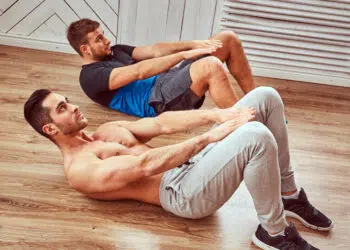
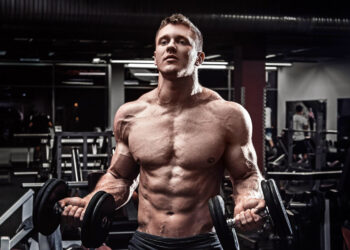

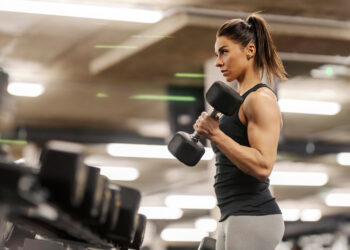
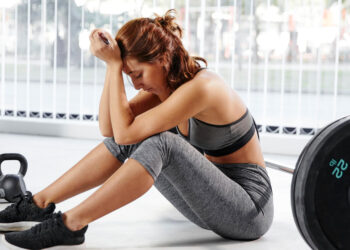

First ,I must “!!!Thank You!!!””, Fitness Volt creators for by far the best fitness website I have ever found. So far I have been able to find ever specific workout ,exercise ,and as well as excellent nutrition information. But the main thing that I must thank you all for is simply the HUGE hand you have given to both myself and I’m sure hundreds if not thousands of others in aiding us all i losing weight ,building strength ,basically getting us all into better shape. “Thank You ,once again.”
Please respond and i’ll tell you how much weight I have lost